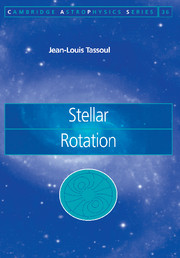Epilogue
Published online by Cambridge University Press: 15 August 2009
Summary
Although stellar rotation has aroused the interest of many distinguished astronomers and mathematicians for almost four hundred years, the theoretical study of the basic physical processes is largely a development of the twentieth century, indeed of the past thirty years or so. In this book I have attempted to present the theory of rotating stars as a branch of classical hydrodynamics, pointing out the differences and similarities between stars and other systems in which rotation is an essential ingredient, such as the Earth's atmosphere and the oceans. Throughout this volume I have thus assumed that the laws governing the internal dynamics of a rotating star are the usual principles of classical mechanics – basically mass conservation, Newton's second law of action, and the laws of thermodynamics. As is well known, one of the reasons why fluid motions in huge natural systems are so complex derives from the fact that the Navier–Stokes equation of motion is inherently nonlinear, so that the superposition of two solutions of a given problem is not necessarily a solution of that problem. In physical terms, this means that it is not possible in general to describe only the largest scale motions in a rotating star, since these flows will almost certainly interact with a whole spectrum of smaller-scale motions. The necessity of incorporating these small-scale, eddylike and/or wavelike motions into the large-scale flows remains as one of the important problems to be solved in astrophysical fluid dynamics.
- Type
- Chapter
- Information
- Stellar Rotation , pp. 245 - 248Publisher: Cambridge University PressPrint publication year: 2000

